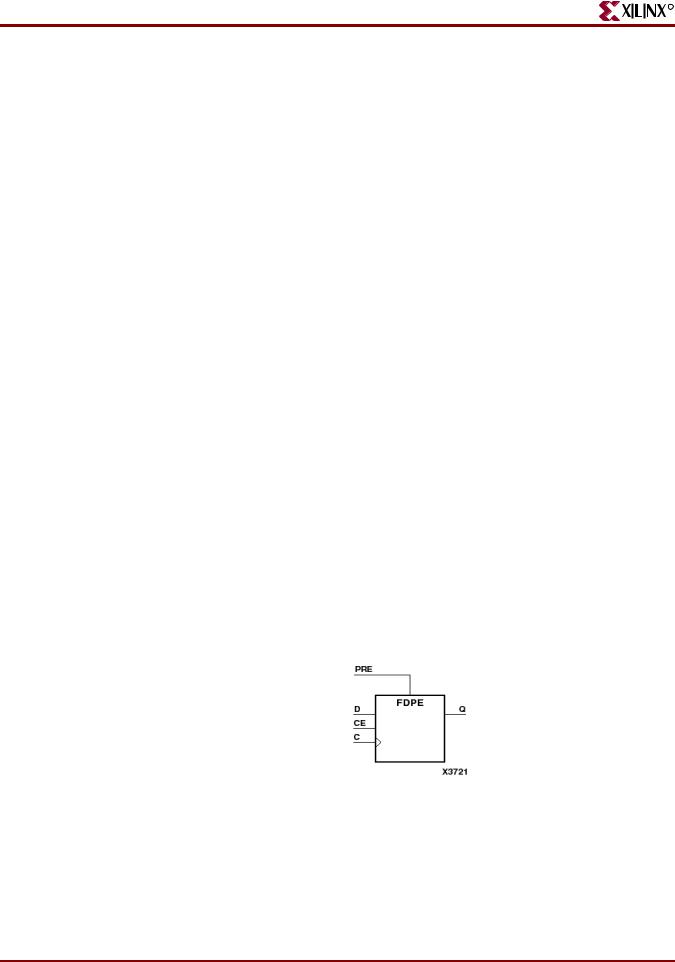
- •XST User Guide
- •Table of Contents
- •About the XST User Guide
- •XST User Guide Contents
- •Additional Resources
- •Conventions
- •Typographical
- •Online Document
- •1 Introduction to the XST User Guide
- •About XST
- •What’s New in Release 10.1
- •Macro Inference
- •Constraints
- •Libraries Support
- •Setting XST Options
- •2 XST HDL Coding Techniques
- •Signed and Unsigned Support in XST
- •Registers HDL Coding Techniques
- •About Registers
- •Registers Log File
- •Registers Related Constraints
- •Registers Coding Examples
- •Latches HDL Coding Techniques
- •About Latches
- •Latches Log File
- •Latches Related Constraints
- •Latches Coding Examples
- •Tristates HDL Coding Techniques
- •About Tristates
- •Tristates Log File
- •Tristates Related Constraints
- •Tristates Coding Examples
- •Counters HDL Coding Techniques
- •About Counters
- •Counters Log File
- •Counters Related Constraints
- •Counters Coding Examples
- •Accumulators HDL Coding Techniques
- •About Accumulators
- •Accumulators in Virtex-4 and Virtex-5 Devices
- •Accumulators Log File
- •Accumulators Related Constraints
- •Accumulators Coding Examples
- •Shift Registers HDL Coding Techniques
- •About Shift Registers
- •Describing Shift Registers
- •Implementing Shift Registers
- •Shift Registers Log File
- •Shift Registers Related Constraints
- •Shift Registers Coding Examples
- •Dynamic Shift Registers HDL Coding Techniques
- •About Dynamic Shift Registers
- •Dynamic Shift Registers Log File
- •Dynamic Shift Registers Related Constraints
- •Dynamic Shift Registers Coding Examples
- •Multiplexers HDL Coding Techniques
- •About Multiplexers
- •Multiplexers Case Statements
- •Multiplexers Log File
- •Multiplexers Related Constraints
- •Multiplexers Coding Examples
- •Decoders HDL Coding Techniques
- •About Decoders
- •Decoders Log File
- •Decoders Related Constraints
- •Decoders Coding Examples
- •Priority Encoders HDL Coding Techniques
- •About Priority Encoders
- •Priority Encoders Log File
- •Priority Encoders Related Constraints
- •Priority Encoders Coding Examples
- •Logical Shifters HDL Coding Techniques
- •About Logical Shifters
- •Logical Shifters Log File
- •Logical Shifters Related Constraints
- •Logical Shifters Coding Examples
- •Arithmetic Operators HDL Coding Techniques
- •About Arithmetic Operators
- •Arithmetic Operators Log File
- •Arithmetic Operators Related Constraints
- •Arithmetic Operators Coding Examples
- •About Adders, Subtractors, and Adders/Subtractors
- •Adders, Subtractors, and Adders/Subtractors Log File
- •Adders, Subtractors, and Adders/Subtractors Related Constraints
- •Adders, Subtractors, and Adders/Subtractors Coding Examples
- •Comparators HDL Coding Techniques
- •About Comparators
- •Comparators Log File
- •Comparators Related Constraints
- •Comparators Coding Examples
- •Multipliers HDL Coding Techniques
- •About Multipliers
- •Large Multipliers Using Block Multipliers
- •Registered Multipliers
- •Multipliers (Virtex-4, Virtex-5, and Spartan-3A D Devices)
- •Multiplication with Constant
- •Multipliers Log File
- •Multipliers Related Constraints
- •Multipliers Coding Examples
- •Sequential Complex Multipliers HDL Coding Techniques
- •About Sequential Complex Multipliers
- •Sequential Complex Multipliers Log File
- •Sequential Complex Multipliers Related Constraints
- •Sequential Complex Multipliers Coding Examples
- •Pipelined Multipliers HDL Coding Techniques
- •About Pipelined Multipliers
- •Pipelined Multipliers Log File
- •Pipelined Multipliers Related Constraints
- •Pipelined Multipliers Coding Examples
- •Multiply Adder/Subtractors HDL Coding Techniques
- •About Multiply Adder/Subtractors
- •Multiply Adder/Subtractors in Virtex-4 and Virtex- 5 Devices
- •Multiply Adder/Subtractors Log File
- •Multiply Adder/Subtractors Related Constraints
- •Multiply Adder/Subtractors Coding Examples
- •Multiply Accumulate HDL Coding Techniques
- •About Multiply Accumulate
- •Multiply Accumulate in Virtex-4 and Virtex-5 Devices
- •Multiply Accumulate Log File
- •Multiply Accumulate Related Constraints
- •Multiply Accumulate Coding Examples
- •Dividers HDL Coding Techniques
- •About Dividers
- •Dividers Log File
- •Dividers Related Constraints
- •Dividers Coding Examples
- •Resource Sharing HDL Coding Techniques
- •About Resource Sharing
- •Resource Sharing Log File
- •Resource Sharing Related Constraints
- •Resource Sharing Coding Examples
- •RAMs and ROMs HDL Coding Techniques
- •About RAMs and ROMs
- •RAMs and ROMs Log File
- •RAMs and ROMs Related Constraints
- •RAMs and ROMs Coding Examples
- •Initializing RAM Coding Examples
- •ROMs Using Block RAM Resources HDL Coding Techniques
- •About ROMs Using Block RAM Resources
- •ROMs Using Block RAM Resources Log File
- •ROMs Using Block RAM Resources Related Constraints
- •ROMs Using Block RAM Resources Coding Examples
- •Pipelined Distributed RAM HDL Coding Techniques
- •About Pipelined Distributed RAM
- •Pipelined Distributed RAM Log File
- •Pipelined Distributed RAM Related Constraints
- •Pipelined Distributed RAM Coding Examples
- •Finite State Machines (FSMs) HDL Coding Techniques
- •About Finite State Machines (FSMs)
- •Describing Finite State Machines (FSMs)
- •State Encoding Techniques
- •RAM-Based FSM Synthesis
- •Safe FSM Implementation
- •Finite State Machines Log File
- •Finite State Machines Related Constraints
- •Finite State Machines Coding Examples
- •Black Boxes HDL Coding Techniques
- •About Black Boxes
- •Black Box Log File
- •Black Box Related Constraints
- •Black Box Coding Examples
- •3 XST FPGA Optimization
- •About XST FPGA Optimization
- •Virtex-Specific Synthesis Options
- •Macro Generation
- •Virtex Macro Generator
- •Arithmetic Functions in Macro Generation
- •Loadable Functions in Macro Generation
- •Multiplexers in Macro Generation
- •Priority Encoders in Macro Generation
- •Decoders in Macro Generation
- •Shift Registers in Macro Generation
- •RAMs in Macro Generation
- •ROMs in Macro Generation
- •DSP48 Block Resources
- •Mapping Logic Onto Block RAM
- •About Mapping Logic Onto Block RAM
- •Mapping Logic Onto Block RAM Log Files
- •Mapping Logic Onto Block RAM Coding Examples
- •Flip-Flop Retiming
- •About Flip-Flop Retiming
- •Limitations of Flip-Flop Retiming
- •Controlling Flip-Flop Retiming
- •Partitions
- •Incremental Synthesis
- •About Incremental Synthesis
- •Incremental Synthesis (INCREMENTAL_SYNTHESIS)
- •Grouping Through Incremental Synthesis Diagram
- •Resynthesize (RESYNTHESIZE)
- •Speed Optimization Under Area Constraint
- •About Speed Optimization Under Area Constraint
- •Speed Optimization Under Area Constraint Examples
- •FPGA Optimization Log File
- •Design Optimization Report
- •Cell Usage Report
- •Timing Report
- •Implementation Constraints
- •Virtex Primitive Support
- •Instantiating Virtex Primitives
- •Generating Primitives Through Attributes
- •Primitives and Black Boxes
- •VHDL and Verilog Virtex Libraries
- •Virtex Primitives Log File
- •Virtex Primitives Related Constraints
- •Virtex Primitives Coding Examples
- •Using the UNIMACRO Library
- •Cores Processing
- •Specifying INIT and RLOC
- •About Specifying INIT and RLOC
- •Passing an INIT Value Via the LUT_MAP Constraint Coding Examples
- •Specifying INIT Value for a Flip-Flop Coding Examples
- •Specifying INIT and RLOC Values for a Flip-Flop Coding Examples
- •Using PCI Flow With XST
- •Satisfying Placement Constraints and Meeting Timing Requirements
- •Preventing Logic and Flip-Flop Replication
- •Disabling Read Cores
- •4 XST CPLD Optimization
- •CPLD Synthesis Options
- •About CPLD Synthesis Options
- •CPLD Synthesis Supported Devices
- •Setting CPLD Synthesis Options
- •Implementation Details for Macro Generation
- •CPLD Synthesis Log File Analysis
- •CPLD Synthesis Constraints
- •Improving Results in CPLD Synthesis
- •About Improving Results in CPLD Synthesis
- •Obtaining Better Frequency
- •Fitting a Large Design
- •5 XST Design Constraints
- •About Constraints
- •List of XST Design Constraints
- •XST General Constraints
- •XST HDL Constraints
- •XST FPGA Constraints (Non-Timing)
- •XST CPLD Constraints (Non-Timing)
- •XST Timing Constraints
- •XST Implementation Constraints
- •Third Party Constraints
- •Setting Global Constraints and Options
- •Setting Synthesis Options
- •Setting HDL Options
- •Setting Xilinx-Specific Options
- •Setting Other XST Command Line Options
- •Custom Compile File List
- •VHDL Attribute Syntax
- •Verilog-2001 Attributes
- •About Verilog-2001 Attributes
- •Verilog-2001 Attributes Syntax
- •Verilog-2001 Limitations
- •Verilog-2001 Meta Comments
- •XST Constraint File (XCF)
- •Specifying the XST Constraint File (XCF)
- •XCF Syntax and Utilization
- •Native and Non-Native User Constraint File (UCF) Constraints Syntax
- •XCF Syntax Limitations
- •Constraints Priority
- •XST-Specific Non-Timing Options
- •XST Command Line Only Options
- •XST Timing Options
- •XST Timing Options: Project Navigator > Process Properties or Command Line
- •XST Timing Options: Xilinx Constraint File (XCF)
- •XST General Constraints
- •Add I/O Buffers (–iobuf)
- •BoxType (BOX_TYPE)
- •Bus Delimiter (–bus_delimiter)
- •Case (–case)
- •Case Implementation Style (–vlgcase)
- •Verilog Macros (-define)
- •Duplication Suffix (–duplication_suffix)
- •Full Case (FULL_CASE)
- •Generate RTL Schematic (–rtlview)
- •Generics (-generics)
- •Hierarchy Separator (–hierarchy_separator)
- •I/O Standard (IOSTANDARD)
- •Keep (KEEP)
- •Keep Hierarchy (KEEP_HIERARCHY)
- •Library Search Order (–lso)
- •Netlist Hierarchy (-netlist_hierarchy)
- •Optimization Effort (OPT_LEVEL)
- •Optimization Goal (OPT_MODE)
- •Parallel Case (PARALLEL_CASE)
- •RLOC
- •Save (S / SAVE)
- •Synthesis Constraint File (–uc)
- •Use Synthesis Constraints File (–iuc)
- •Verilog Include Directories (–vlgincdir)
- •Verilog 2001 (–verilog2001)
- •HDL Library Mapping File (–xsthdpini)
- •Work Directory (–xsthdpdir)
- •XST HDL Constraints
- •About XST HDL Constraints
- •Automatic FSM Extraction (FSM_EXTRACT)
- •Enumerated Encoding (ENUM_ENCODING)
- •Equivalent Register Removal (EQUIVALENT_REGISTER_REMOVAL)
- •FSM Encoding Algorithm (FSM_ENCODING)
- •Mux Extraction (MUX_EXTRACT)
- •Register Power Up (REGISTER_POWERUP)
- •Resource Sharing (RESOURCE_SHARING)
- •Safe Recovery State (SAFE_RECOVERY_STATE)
- •Safe Implementation (SAFE_IMPLEMENTATION)
- •Signal Encoding (SIGNAL_ENCODING)
- •XST FPGA Constraints (Non-Timing)
- •Asynchronous to Synchronous (ASYNC_TO_SYNC)
- •Automatic BRAM Packing (AUTO_BRAM_PACKING)
- •BRAM Utilization Ratio (BRAM_UTILIZATION_RATIO)
- •Buffer Type (BUFFER_TYPE)
- •Extract BUFGCE (BUFGCE)
- •Cores Search Directories (–sd)
- •Decoder Extraction (DECODER_EXTRACT)
- •DSP Utilization Ratio (DSP_UTILIZATION_RATIO)
- •FSM Style (FSM_STYLE)
- •Power Reduction (POWER)
- •Read Cores (READ_CORES)
- •Resynthesize (RESYNTHESIZE)
- •Incremental Synthesis (INCREMENTAL_SYNTHESIS)
- •Logical Shifter Extraction (SHIFT_EXTRACT)
- •LUT Combining (LC)
- •Map Logic on BRAM (BRAM_MAP)
- •Max Fanout (MAX_FANOUT)
- •Move First Stage (MOVE_FIRST_STAGE)
- •Move Last Stage (MOVE_LAST_STAGE)
- •Multiplier Style (MULT_STYLE)
- •Mux Style (MUX_STYLE)
- •Number of Global Clock Buffers (–bufg)
- •Number of Regional Clock Buffers (–bufr)
- •Optimize Instantiated Primitives (OPTIMIZE_PRIMITIVES)
- •Pack I/O Registers Into IOBs (IOB)
- •Priority Encoder Extraction (PRIORITY_EXTRACT)
- •RAM Extraction (RAM_EXTRACT)
- •RAM Style (RAM_STYLE)
- •Reduce Control Sets (REDUCE_CONTROL_SETS)
- •Register Balancing (REGISTER_BALANCING)
- •Register Duplication (REGISTER_DUPLICATION)
- •ROM Extraction (ROM_EXTRACT)
- •ROM Style (ROM_STYLE)
- •Shift Register Extraction (SHREG_EXTRACT)
- •Slice Packing (–slice_packing)
- •Use Low Skew Lines (USELOWSKEWLINES)
- •XOR Collapsing (XOR_COLLAPSE)
- •Slice (LUT-FF Pairs) Utilization Ratio (SLICE_UTILIZATION_RATIO)
- •Map Entity on a Single LUT (LUT_MAP)
- •Use Carry Chain (USE_CARRY_CHAIN)
- •Convert Tristates to Logic (TRISTATE2LOGIC)
- •Use Clock Enable (USE_CLOCK_ENABLE)
- •Use Synchronous Set (USE_SYNC_SET)
- •Use Synchronous Reset (USE_SYNC_RESET)
- •XST CPLD Constraints (Non-Timing)
- •Clock Enable (–pld_ce)
- •Data Gate (DATA_GATE)
- •Macro Preserve (–pld_mp)
- •No Reduce (NOREDUCE)
- •WYSIWYG (–wysiwyg)
- •XOR Preserve (–pld_xp)
- •XST Timing Constraints
- •Applying Timing Constraints
- •Cross Clock Analysis (–cross_clock_analysis)
- •Write Timing Constraints (–write_timing_constraints)
- •Clock Signal (CLOCK_SIGNAL)
- •Global Optimization Goal (–glob_opt)
- •XCF Timing Constraint Support
- •Period (PERIOD)
- •Offset (OFFSET)
- •From-To (FROM-TO)
- •Timing Name (TNM)
- •Timing Name on a Net (TNM_NET)
- •Timegroup (TIMEGRP)
- •Timing Ignore (TIG)
- •XST Implementation Constraints
- •About Implementation Constraints
- •Implementation Constraints Syntax Examples
- •RLOC
- •NOREDUCE
- •PWR_MODE
- •XST-Supported Third Party Constraints
- •XST Equivalents to Third Party Constraints
- •Third Party Constraints Syntax Examples
- •6 XST VHDL Language Support
- •About XST VHDL Language Support
- •VHDL IEEE Support
- •About VHDL IEEE Support
- •VHDL IEEE Conflicts
- •Non-LRM Compliant Constructs in VHDL
- •XST VHDL File Type Support
- •About XST VHDL File Type Support
- •XST VHDL File Type Support Table
- •Debugging Using Write Operation in VHDL
- •Rules for Debugging Using Write Operation in VHDL
- •VHDL Data Types
- •Accepted VHDL Data Types
- •VHDL Overloaded Data Types
- •VHDL Multi-Dimensional Array Types
- •VHDL Record Types
- •VHDL Initial Values
- •About VHDL Initial Values
- •VHDL Local Reset/Global Reset
- •Default Initial Values on Memory Elements in VHDL
- •VHDL Objects
- •Signals in VHDL
- •Variables in VHDL
- •Constants in VHDL
- •VHDL Operators
- •Entity and Architecture Descriptions in VHDL
- •VHDL Circuit Descriptions
- •VHDL Entity Declarations
- •VHDL Architecture Declarations
- •VHDL Component Instantiation
- •VHDL Recursive Component Instantiation
- •VHDL Component Configuration
- •VHDL Generic Parameter Declarations
- •VHDL Generic and Attribute Conflicts
- •VHDL Combinatorial Circuits
- •VHDL Concurrent Signal Assignments
- •VHDL Generate Statements
- •VHDL Combinatorial Processes
- •VHDL If...Else Statements
- •VHDL Case Statements
- •VHDL For...Loop Statements
- •VHDL Sequential Circuits
- •About VHDL Sequential Circuits
- •VHDL Sequential Process With a Sensitivity List
- •VHDL Sequential Process Without a Sensitivity List
- •Register and Counter Descriptions VHDL Coding Examples
- •VHDL Multiple Wait Statements Descriptions
- •VHDL Functions and Procedures
- •About VHDL Functions and Procedures
- •VHDL Functions and Procedures Examples
- •VHDL Assert Statements
- •About VHDL Assert Statements
- •SINGLE_SRL Describing a Shift Register
- •Using Packages to Define VHDL Models
- •About Using Packages to Define VHDL Models
- •Using Standard Packages to Define VHDL Models
- •Using IEEE Packages to Define VHDL Models
- •Using Synopsys Packages to Define VHDL Models
- •VHDL Constructs Supported in XST
- •VHDL Design Entities and Configurations
- •VHDL Expressions
- •VHDL Statements
- •VHDL Reserved Words
- •7 XST Verilog Language Support
- •About XST Verilog Language Support
- •Behavioral Verilog
- •Variable Part Selects
- •Structural Verilog Features
- •About Structural Verilog Features
- •Structural Verilog Coding Examples
- •Verilog Parameters
- •Verilog Parameter and Attribute Conflicts
- •About Verilog Parameter and Attribute Conflicts
- •Verilog Parameter and Attribute Conflicts Precedence
- •Verilog Limitations in XST
- •Verilog Case Sensitivity
- •Verilog Blocking and Nonblocking Assignments
- •Verilog Integer Handling
- •Verilog Attributes and Meta Comments
- •About Verilog Attributes and Meta Comments
- •Verilog-2001 Attributes
- •Verilog Meta Comments
- •Verilog Constructs Supported in XST
- •Verilog Constants Supported in XST
- •Verilog Data Types Supported in XST
- •Verilog Continuous Assignments Supported in XST
- •Verilog Procedural Assignments Supported in XST
- •Verilog Design Hierarchies Supported in XST
- •Verilog Compiler Directives Supported in XST
- •Verilog System Tasks and Functions Supported in XST
- •Verilog Primitives
- •Verilog Reserved Keywords
- •Verilog-2001 Support in XST
- •8 XST Behavioral Verilog Language Support
- •Behavioral Verilog Variable Declarations
- •About Behavioral Verilog Variable Declarations
- •Behavioral Verilog Variable Declarations Coding Examples
- •Behavioral Verilog Initial Values
- •About Behavioral Verilog Initial Values
- •Behavioral Verilog Initial Values Coding Examples
- •Behavioral Verilog Local Reset
- •About Behavioral Verilog Local Reset
- •Behavioral Verilog Local Reset Coding Examples
- •Behavioral Verilog Arrays
- •Behavioral Verilog Multi-Dimensional Arrays
- •About Behavioral Verilog Multi-Dimensional Arrays
- •Behavioral Verilog Multi-Dimensional Arrays Coding Examples
- •Behavioral Verilog Data Types
- •About Behavioral Verilog Data Types
- •Behavioral Verilog Data Types Coding Examples
- •Behavioral Verilog Legal Statements
- •Behavioral Verilog Expressions
- •About Behavioral Verilog Expressions
- •Operators Supported in Behavioral Verilog
- •Expressions Supported in Behavioral Verilog
- •Results of Evaluating Expressions in Behavioral Verilog
- •Behavioral Verilog Blocks
- •Behavioral Verilog Modules
- •Behavioral Verilog Module Declarations
- •About Behavioral Verilog Module Declarations
- •Behavioral Verilog Module Declaration Coding Examples
- •Behavioral Verilog Continuous Assignments
- •About Behavioral Verilog Continuous Assignments
- •Behavioral Verilog Continuous Assignments Coding Examples
- •Behavioral Verilog Procedural Assignments
- •About Behavioral Verilog Procedural Assignments
- •Behavioral Verilog Combinatorial Always Blocks
- •Behavioral Verilog If...Else Statement
- •Behavioral Verilog Case Statements
- •Behavioral Verilog For and Repeat Loops
- •Behavioral Verilog While Loops
- •Behavioral Verilog Sequential Always Blocks
- •Behavioral Verilog Assign and Deassign Statements
- •Behavioral Verilog Assignment Extension Past 32 Bits
- •Behavioral Verilog Tasks and Functions
- •Behavioral Verilog Recursive Tasks and Functions
- •Behavioral Verilog Constant Functions
- •Behavioral Verilog Blocking Versus Non-Blocking Procedural Assignments
- •Behavioral Verilog Constants
- •Behavioral Verilog Macros
- •Behavioral Verilog Include Files
- •Behavioral Verilog Comments
- •Behavioral Verilog Generate Statements
- •Behavioral Verilog Generate For Statements
- •Behavioral Verilog Generate If... else Statements
- •Behavioral Verilog Generate Case Statements
- •9 XST Mixed Language Support
- •About Mixed Language Support
- •Mixed Language Project Files
- •VHDL and Verilog Boundary Rules in Mixed Language Projects
- •Instantiating a Verilog Module in a VHDL Design
- •Instantiating a VHDL Design Unit in a Verilog Design
- •Port Mapping in Mixed Language Projects
- •VHDL in Verilog Port Mapping
- •Verilog in VHDL Port Mapping
- •VHDL in Mixed Language Port Mapping
- •Verilog in Mixed Language Port Mapping
- •Generics Support in Mixed Language Projects
- •Library Search Order (LSO) Files in Mixed Language Projects
- •About the Library Search Order (LSO) File
- •Specifying the Library Search Order (LSO) File in Project Navigator
- •Specifying the Library Search Order (LSO) File in the Command Line
- •Library Search Order (LSO) Rules
- •10 XST Log Files
- •XST FPGA Log File Contents
- •XST FPGA Log File Copyright Statement
- •XST FPGA Log File Table of Contents
- •XST FPGA Log File Synthesis Options Summary
- •XST FPGA Log File HDL Compilation
- •XST FPGA Log File Design Hierarchy Analyzer
- •XST FPGA Log File HDL Analysis
- •XST FPGA Log File HDL Synthesis Report
- •XST FPGA Log File Advanced HDL Synthesis Report
- •XST FPGA Log File Low Level Synthesis
- •XST FPGA Log File Partition Report
- •XST FPGA Log File Final Report
- •Reducing the Size of the XST Log File
- •Use Message Filtering
- •Use Quiet Mode
- •Use Silent Mode
- •Hide Specific Messages
- •Macros in XST Log Files
- •XST Log File Examples
- •11 XST Naming Conventions
- •XST Net Naming Conventions
- •XST Instance Naming Conventions
- •XST Name Generation Control
- •12 XST Command Line Mode
- •Running XST in Command Line Mode
- •XST File Types in Command Line Mode
- •Temporary Files in Command Line Mode
- •Names With Spaces in Command Line Mode
- •Launching XST in Command Line Mode
- •Launching XST in Command Line Mode Using the XST Shell
- •Launching XST in Command Line Mode Using a Script File
- •Setting Up an XST Script
- •Setting Up an XST Script Using the Run Command
- •Setting Up an XST Script Using the Set Command
- •Setting Up an XST Script Using the Elaborate Command
- •Synthesizing VHDL Designs Using Command Line Mode
- •Synthesizing VHDL Designs Using Command Line Mode (Example)
- •Running XST in Script Mode (VHDL)
- •Synthesizing Verilog Designs Using Command Line Mode
- •Synthesizing Verilog Designs Using Command Line Mode (Example)
- •Running XST in Script Mode (Verilog)
- •Synthesizing Mixed Designs Using Command Line Mode
- •Synthesizing Mixed Designs Using Command Line Mode (Example)
- •Running XST in Script Mode (Mixed Language)

R
Registers HDL Coding Techniques
Registers HDL Coding Techniques
This section discusses Registers HDL Coding Techniques, and includes:
•“About Registers”
•“Registers Log File”
•“Registers Related Constraints”
•“Registers Coding Examples”
About Registers
XST recognizes flip-flops with the following control signals:
•Asynchronous Set/Reset
•Synchronous Set/Reset
•Clock Enable
For more information, see “Specifying INIT and RLOC.”
Registers Log File
The XST log file reports the type and size of recognized flip-flops during the Macro
Recognition step.
...
===============================================================
* HDL Synthesis *
===============================================================
Synthesizing Unit <registers_5>.
Related source |
file is "registers_5.vhd". |
Found 4-bit register for signal <Q>. |
|
Summary: |
|
inferred |
4 D-type flip-flop(s). |
Unit <registers_5> |
synthesized. |
===============================================================
HDL Synthesis Report
Macro Statistics |
|
|
# Registers |
: |
1 |
4-bit register |
: |
1 |
===============================================================
===============================================================
* Advanced HDL Synthesis *
===============================================================
===============================================================
Advanced HDL Synthesis Report
Macro Statistics |
|
|
# Registers |
: |
4 |
Flip-Flops/Latches |
: |
4 |
===============================================================
...
XST User Guide |
www.xilinx.com |
25 |
10.1

Chapter 2: XST HDL Coding Techniques
R
With the introduction of new device families such as Virtex™-4, XST may optimize different slices of the same register in different ways. For example, XST may push a part of a register into a DSP48 block, while another part may be implemented on slices, or even become a part of a shift register. XST reports the total number of FF bits in the design in the HDL Synthesis Report after the Advanced HDL Synthesis step.
Registers Related Constraints
•“Pack I/O Registers Into IOBs (IOB)”
•“Register Duplication (REGISTER_DUPLICATION)”
•“Equivalent Register Removal (EQUIVALENT_REGISTER_REMOVAL)”
•“Register Balancing (REGISTER_BALANCING)”
Registers Coding Examples
This section gives the following Registers examples:
•“Flip-Flop With Positive-Edge Clock”
•“Flip-Flop With Negative-Edge Clock and Asynchronous Reset”
•“Flip-Flop With Positive-Edge Clock and Synchronous Set”
•“Flip-Flop With Positive-Edge Clock and Clock Enable”
•“4-Bit Register With Positive-Edge Clock, Asynchronous Set, and Clock Enable”
The coding examples in this section are accurate as of the date of publication. Download updates from ftp://ftp.xilinx.com/pub/documentation/misc/examples_v9.zip.
Flip-Flop With Positive-Edge Clock
This section discusses Flip-Flop With Positive-Edge Clock, and includes:
•“Flip-Flop With Positive-Edge Clock Diagram”
•“Flip-Flop With Positive-Edge Clock Pin Descriptions”
•“Flip-Flop With Positive Edge Clock VHDL Coding Example”
•“Flip-Flop With Positive-Edge Clock Verilog Coding Example”
Figure 2-1: Flip-Flop With Positive-Edge Clock Diagram
26 |
www.xilinx.com |
XST User Guide |
|
|
10.1 |

R
Registers HDL Coding Techniques
Table 2-3: |
Flip-Flop With Positive-Edge Clock Pin Descriptions |
|
|
|
|
IO Pins |
|
Description |
|
|
|
D |
|
Data Input |
|
|
|
C |
|
Positive-Edge Clock |
|
|
|
Q |
|
Data Output |
|
|
|
Flip-Flop With Positive Edge Clock VHDL Coding Example
--
-- Flip-Flop with Positive-Edge Clock
--
library ieee;
use ieee.std_logic_1164.all;
entity registers_1 is port(C, D : in std_logic;
Q : out std_logic); end registers_1;
architecture archi of registers_1 is begin
process (C) begin
if (C'event and C='1') then Q <= D;
end if; end process;
end archi;
When using VHDL for a positive-edge clock, instead of using:
if (C'event and C='1') then
you can also use:
if (rising_edge(C)) then
Flip-Flop With Positive-Edge Clock Verilog Coding Example
//
// Flip-Flop with Positive-Edge Clock
//
module v_registers_1 (C, D, Q); input C, D;
output Q; reg Q;
always @(posedge C) begin
Q <= D;
end
endmodule
XST User Guide |
www.xilinx.com |
27 |
10.1

Chapter 2: XST HDL Coding Techniques
R
Flip-Flop With Negative-Edge Clock and Asynchronous Reset
This section discusses Flip-Flop With Negative-Edge Clock and Asynchronous Reset, and includes:
•“Flip-Flop With Negative-Edge Clock and Asynchronous Reset Diagram”
•“Flip-Flop With Negative-Edge Clock and Asynchronous Reset Pin Descriptions”
•“Flip-Flop With Negative-Edge Clock and Asynchronous Reset VHDL Coding Example”
•“Flip-Flop With Negative-Edge Clock and Asynchronous Reset Verilog Coding Example”
D |
FDC_1 |
Q |
|
|
|
||
C |
|
|
|
CLR |
|
|
X3847 |
|
|
||
|
|
|
|
Figure 2-2: Flip-Flop With Negative-Edge Clock and Asynchronous Reset Diagram
Table 2-4: Flip-Flop With Negative-Edge Clock and Asynchronous Reset Pin
Descriptions
IO Pins |
Description |
|
|
D |
Data Input |
|
|
C |
Negative-Edge Clock |
|
|
CLR |
Asynchronous Reset (Active High) |
|
|
Q |
Data Output |
|
|
Flip-Flop With Negative-Edge Clock and Asynchronous Reset VHDL Coding Example
--
-- Flip-Flop with Negative-Edge Clock and Asynchronous Reset
--
library ieee;
use ieee.std_logic_1164.all;
entity registers_2 |
is |
port(C, D, CLR |
: in std_logic; |
Q |
: out std_logic); |
end registers_2; |
|
architecture archi |
of registers_2 is |
begin |
|
process (C, CLR) begin
28 |
www.xilinx.com |
XST User Guide |
|
|
10.1 |

R
Registers HDL Coding Techniques
if (CLR = '1')then Q <= '0';
elsif (C'event and C='0')then Q <= D;
end if; end process;
end archi;
Flip-Flop With Negative-Edge Clock and Asynchronous Reset Verilog Coding Example
//
// Flip-Flop with Negative-Edge Clock and Asynchronous Reset
//
module v_registers_2 (C, D, CLR, Q); input C, D, CLR;
output Q; reg Q;
always @(negedge C or posedge CLR) begin
if (CLR)
Q <= 1'b0; else
Q <= D;
end
endmodule
Flip-Flop With Positive-Edge Clock and Synchronous Set
This section discusses Flip-Flop With Positive-Edge Clock and Synchronous Set, and includes:
•“Flip-Flop With Positive-Edge Clock and Synchronous Set Diagram”
•“Flip-Flop With Positive-Edge Clock and Synchronous Set Pin Descriptions”
•“Flip-Flop With Positive-Edge Clock and Synchronous Set VHDL Coding Example”
•“Flip-Flop With Positive-Edge Clock and Synchronous Set Verilog Coding Example”
S |
|
|
|
|
|
|
|
|
|
D |
FDS |
Q |
||
|
|
|||
C |
|
|
|
|
|
|
|
X3722 |
|
|
|
|
||
Figure 2-3: Flip-Flop With Positive-Edge Clock and Synchronous Set Diagram
XST User Guide |
www.xilinx.com |
29 |
10.1

Chapter 2: XST HDL Coding Techniques
R
Table 2-5: Flip-Flop With Positive-Edge Clock and Synchronous Set Pin Descriptions
IO Pins |
Description |
|
|
D |
Data Input |
|
|
C |
Positive-Edge Clock |
|
|
S |
Synchronous Set (Active High) |
|
|
Q |
Data Output |
|
|
Flip-Flop With Positive-Edge Clock and Synchronous Set VHDL Coding Example
--
-- Flip-Flop with Positive-Edge Clock and Synchronous Set
--
library ieee;
use ieee.std_logic_1164.all;
entity registers_3 is
port(C, D, S : |
in |
std_logic; |
|
Q |
: |
out |
std_logic); |
end registers_3;
architecture archi of registers_3 is begin
process (C) begin
if (C'event and C='1') then if (S='1') then
Q <= '1';
else
Q <= D; end if;
end if; end process;
end archi;
Flip-Flop With Positive-Edge Clock and Synchronous Set Verilog Coding Example
//
// Flip-Flop with Positive-Edge Clock and Synchronous Set
//
module v_registers_3 (C, D, S, Q); input C, D, S;
output Q; reg Q;
always @(posedge C) begin
if (S)
Q <= 1'b1; else
Q <= D;
end
endmodule
30 |
www.xilinx.com |
XST User Guide |
|
|
10.1 |

R
Registers HDL Coding Techniques
Flip-Flop With Positive-Edge Clock and Clock Enable
This section discusses Flip-Flop With Positive-Edge Clock and Clock Enable, and includes:
•“Flip-Flop With Positive-Edge Clock and Clock Enable Diagram”
•“Flip-Flop With Positive-Edge Clock and Clock Enable Pin Descriptions”
•“Flip-Flop With Positive-Edge Clock and Clock Enable VHDL Coding Example”
•“Flip-Flop With Positive-Edge Clock and Clock Enable Verilog Coding Example”
FDE
D
CE |
Q |
C
X8361
Figure 2-4: Flip-Flop With Positive-Edge Clock and Clock Enable Diagram
Table 2-6: Flip-Flop With Positive-Edge Clock and Clock Enable Pin Descriptions
IO Pins |
Description |
|
|
D |
Data Input |
|
|
C |
Positive-Edge Clock |
|
|
CE |
Clock Enable (Active High) |
|
|
Q |
Data Output |
|
|
Flip-Flop With Positive-Edge Clock and Clock Enable VHDL Coding Example
--
-- Flip-Flop with Positive-Edge Clock and Clock Enable
--
library ieee;
use ieee.std_logic_1164.all;
entity registers_4 is
port(C, D, CE : in std_logic;
Q : out std_logic); end registers_4;
architecture archi of registers_4 is begin
process (C) begin
if (C'event and C='1') then if (CE='1') then
Q <= D; end if;
end if; end process;
end archi;
XST User Guide |
www.xilinx.com |
31 |
10.1

Chapter 2: XST HDL Coding Techniques
Flip-Flop With Positive-Edge Clock and Clock Enable Verilog Coding Example
//
// Flip-Flop with Positive-Edge Clock and Clock Enable
//
module v_registers_4 (C, D, CE, Q); input C, D, CE;
output Q; reg Q;
always @(posedge C) begin
if (CE)
Q <= D;
end
endmodule
4-Bit Register With Positive-Edge Clock, Asynchronous Set, and Clock
Enable
R
This section discusses 4-Bit Register With Positive-Edge Clock, Asynchronous Set, and Clock Enable, and includes:
•“Flip-Flop With Positive-Edge Clock and Clock Enable Diagram”
•“4-Bit Register With Positive-Edge Clock, Asynchronous Set, and Clock Enable Pin Descriptions”
•“4-Bit Register With Positive-Edge Clock, Asynchronous Set, and Clock Enable VHDL Coding Example”
•“4-Bit Register With Positive-Edge Clock, Asynchronous Set, and Clock Enable Verilog Coding Example”
PRE
|
|
|
|
D |
FDPE |
Q |
|
|
|
||
CE |
|
|
|
C |
|
|
|
|
|
|
|
X3721
Figure 2-5: 4-Bit Register With Positive-Edge Clock, Asynchronous Set, and Clock
Enable Diagram
Table 2-7: 4-Bit Register With Positive-Edge Clock, Asynchronous Set, and Clock Enable Pin Descriptions
IO Pins |
Description |
|
|
D |
Data Input |
|
|
C |
Positive-Edge Clock |
|
|
PRE |
Asynchronous Set (Active High) |
|
|
32 |
www.xilinx.com |
XST User Guide |
|
|
10.1 |

R
Registers HDL Coding Techniques
Table 2-7: 4-Bit Register With Positive-Edge Clock, Asynchronous Set, and Clock Enable Pin Descriptions (Cont’d)
IO Pins |
Description |
|
|
CE |
Clock Enable (Active High) |
|
|
Q |
Data Output |
|
|
4-Bit Register With Positive-Edge Clock, Asynchronous Set, and Clock Enable VHDL Coding Example
--
-- 4-bit Register with Positive-Edge Clock, Asynchronous Set and Clock Enable
--
library ieee;
use ieee.std_logic_1164.all;
entity registers_5 is
port(C, CE, PRE : in std_logic;
D : in std_logic_vector (3 downto 0);
Q : out std_logic_vector (3 downto 0)); end registers_5;
architecture archi of registers_5 is begin
process (C, PRE) begin
if (PRE='1') then Q <= "1111";
elsif (C'event and C='1')then if (CE='1') then
Q <= D; end if;
end if; end process;
end archi;
4-Bit Register With Positive-Edge Clock, Asynchronous Set, and Clock Enable Verilog Coding Example
//
// 4-bit Register with Positive-Edge Clock, Asynchronous Set and Clock Enable
//
module v_registers_5 (C, D, CE, PRE, Q);
input |
C, CE, PRE; |
input |
[3:0] D; |
output |
[3:0] Q; |
reg |
[3:0] Q; |
always |
@(posedge C or posedge PRE) |
begin |
|
if |
(PRE) |
XST User Guide |
www.xilinx.com |
33 |
10.1
